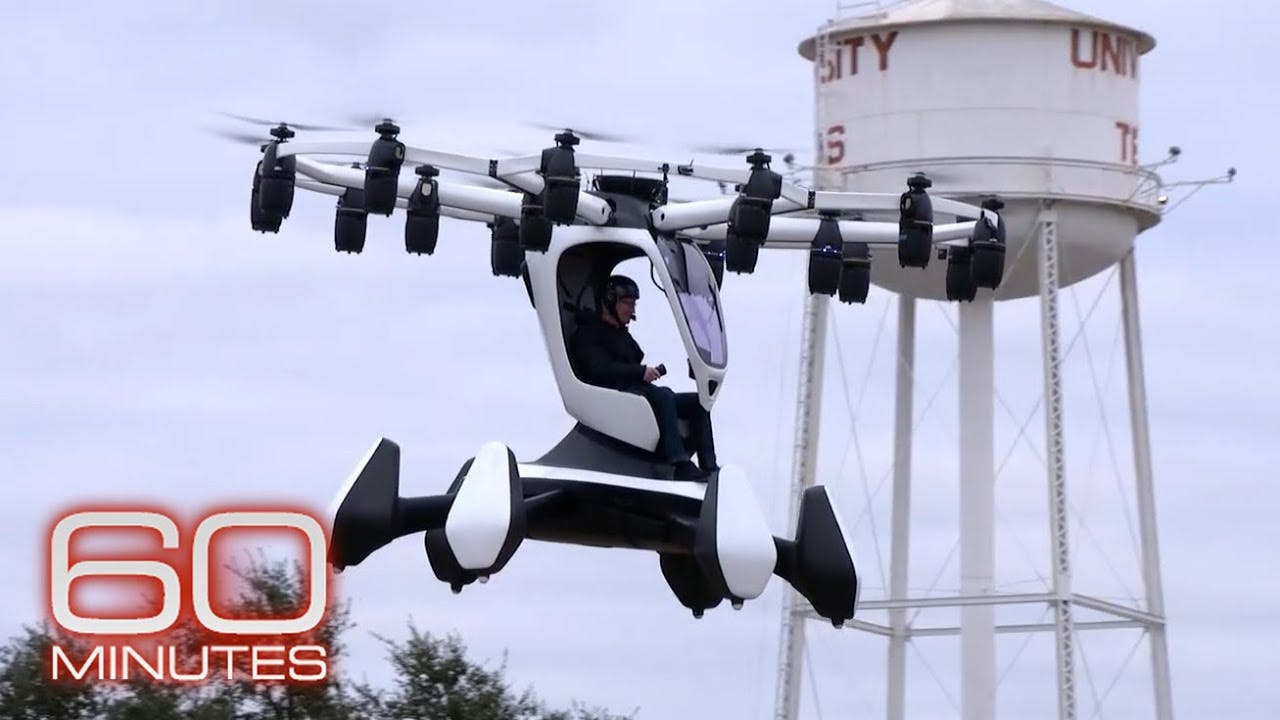Flying Taxis; Supersonic Flight; Self-driving Trucks; Future Factory | 60 Minutes Full Episodes
()

eVTOLs (00:00:11)
- Electric vertical takeoff and landing (eVTOL) aircraft, also known as flying taxis, are being developed as a faster, safer, and greener mode of transportation for congested cities.
- eVTOLs are battery-powered and can take off and land vertically, making them suitable for urban areas.
- Companies like Joby Aviation and Volocopter are developing various types of eVTOLs, including cargo carriers, air ambulances, and air taxis, with some being piloted and others autonomous.
- Joby Aviation's eVTOL, the Joby S4, has six propellers, four batteries, and can fly 150 miles on a single charge with a top speed of around 200 mph.
- Volocopter is developing a fully autonomous flying taxi service with no pilot on board and plans to launch its four-seater air taxi service in the world's 20 busiest cities within the next decade.
- The certification process for eVTOLs involves assessing the design, operation, and airspace integration to ensure safety before they can be widely used.
- The FAA has not yet certified autonomous flying taxis, but acting administrator Billy Nolan believes that hailing a piloted air taxi by 2024 is possible.
Supersonic (00:13:33)
- Boom Supersonic, Spike, and Hermus are private companies developing new supersonic aircraft.
- Boom has built a supersonic test plane and received an order for 15 Overture passenger jets from United Airlines.
- Boom aims to make supersonic travel affordable with a ticket price of $100 for a four-hour flight anywhere in the world.
- Challenges include high development and certification costs, lack of sustainable aviation fuel, and regulatory hurdles.
- Boom is working with NASA to develop the X-59 test plane to reduce the sonic boom and potentially lift the ban on civilian supersonic flights over land.
- The X-59 aircraft, featuring a TV screen instead of a windshield, has successfully achieved supersonic flight during simulations.
- Test pilot Nels Larsson successfully landed the X-59 in a simulator despite its unique design.
- Supersonic commercial flights could significantly reduce travel time, with a potential timeline of 2035 if successful.
- Boom Supersonic has chosen Greensboro, North Carolina as the location for its factory but still requires an engine for the Overture aircraft.
Kings of the Road (00:27:08)
- Self-driving trucks are being tested on public roads by companies like Starsky Robotics and TuSimple, with the potential to revolutionize the trucking industry and transform the US transportation grid.
- Companies like UPS, Amazon, and the US Postal Service are already utilizing self-driving trucks to transport freight, reducing shipping time and costs by enabling coast-to-coast travel in two days.
- The technology employs an array of cameras, sensors, and radar devices for navigation in various weather conditions, while TuSimple's trucks use a combination of sensors, cameras, and artificial intelligence for decision-making on the road.
- Concerns exist among truckers regarding potential job losses and safety risks associated with driverless trucks, along with the lack of oversight and regulation of this technology.
- The Arizona Department of Transportation (DOT) currently lacks a formal inspection process for self-driving trucks, despite ongoing testing on public roads without public notification or data sharing with state authorities.
- Advocates argue that driverless trucks enhance safety by eliminating texting, drunk driving, and speeding, but the competitive nature of the trucking industry raises concerns about prioritizing cost-saving measures over safety.
- Policy decisions will play a crucial role in determining the outcomes and regulations for self-driving trucks within the transportation industry.
The Future Factory (00:40:32)
- The MIT Media Lab, founded in 1984, is a research lab and graduate school program known for developing groundbreaking technologies such as touchscreens, automated driving instructions, wearable technology, and electronic ink.
- Led by Joi Ito, the Media Lab fosters a collaborative environment where students from diverse disciplines work on unconventional projects, including self-driving taxi tricycles, phones that perform retinal eye exams, and teaching robots.
- Professor Hugh Herr's Advanced Prosthetics lab combines toy design, future instrument design, and machine-nervous system interfacing to create unique technologies like a prosthetic foot that allows wearers to control and feel the limb naturally.
- Arnav Kapur's system intercepts electrical signals from the brain, enabling him to surf the internet with his mind.
- Adam Horowitz's research involves planting ideas for dreams and recording conversations with the dreamer to capture creative ideas.
- Caleb Harper's project focuses on building "food computers" or indoor farms with controlled climate conditions to study and replicate ideal growing conditions for specific crops, envisioning a future where plants can be grown in air with a custom mix of moisture and nutrients for faster growth and multiple harvests per year.
- The Media Lab's funding model, based on membership fees from 90 companies, allows faculty and students to work on projects without the constraints of grant proposals or permission, fostering an environment conducive to exploration and innovation.